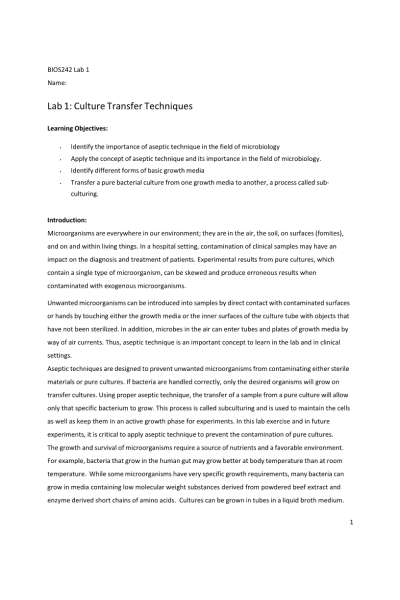BIOS 242 Week 1 Lab 1; Culture Transfer Techniques
-
$20.00
| Institution | BIOS 242 Fundamentals of Microbiology with Lab - Chamberlain |
| Contributor | Anika Fultz |
Lab 1: Culture Transfer Techniques
Learning Objectives:
- Identify the importance of aseptic technique in the field of microbiology
- Apply the concept of aseptic technique and its importance in the field of microbiology.
- Identify different forms of basic growth media
- Transfer a pure bacterial culture from one growth media to another, a process called sub- culturing.
Introduction:
Materials:
Nutrient broth, Nutrient agar slants, Nutrient agar stabs, liquid and slant cultures of Serratia marcescens,
inoculating loop, inoculating needle, incinerators
Method:
- Remove extraneous materials from the lab bench and disinfect it with 10% bleach solution.
- Obtain 24 hour cultures of Serratia marcescens (broth and slant).
- Label the sterile tubes (broth, slant, and stab) with the name of the organism and your group designation.
- Loop sterilization for those labs with reusable metal loops following the instructions below (a and b). If your lab uses sterile plastic loops, use a new loop for each transfer being mindful not to touch it on any surface.
- Transfer from a broth culture to a new broth culture by following the steps outlined in a-h.
- Transfer from a broth culture to a slant culture
- Transfer from a broth culture to a slab culture
- Transfer from a slant culture to a broth, slant, or stab culture
- When finished, incubate the tubes at approximately 25o C for 24 to 48 hours.
Next lab class:
- Examine the cultures for appearance of growth. Broth cultures should appear turbid (cloudy). Slant and stab cultures should have orange-red growth on the surface of the slant and along the line of inoculation in the slant culture.
- Record your findings in the Lab Report.
Lab Report
Purpose:
Please describe in complete sentences and in your own words, the purpose of this experiment. Allows us to practice the sterile technique
Observations:
Broth Stock Culture: EC
Slant Stock Culture: SM
Questions:
- Why is proper aseptic technique important in microbiology?
- What is the importance of flaming the inoculating loop or needle before and after each inoculation?
- If you do not wait 10 – 20 seconds after flame sterilizing the inoculating instruments before obtaining the sample, what might be the consequences?
- Why is it important to flame neck of the tubes immediately after uncapping and before recapping the tubes?
- The stab tube was inoculated with a needle. Why was this used instead of the inoculating loop?
- The Serratia marcescens cultures were accidently incubated at 37o C instead of 25o C. You observed growth but the slant and stab cultures were white, not orange-red. Does this mean your sample was contaminated?
| Instituition / Term | |
| Term | Uploaded 2023 |
| Institution | BIOS 242 Fundamentals of Microbiology with Lab - Chamberlain |
| Contributor | Anika Fultz |















































